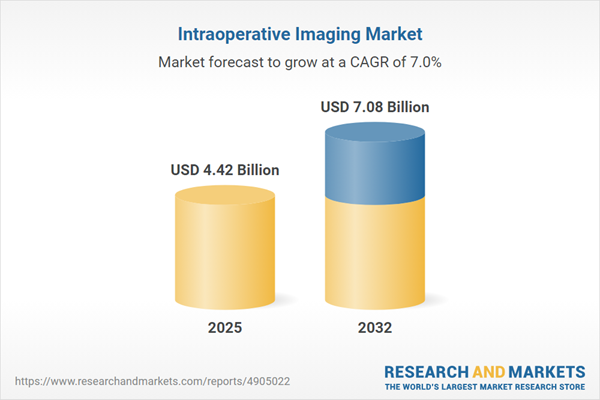Speak directly to the analyst to clarify any post sales queries you may have.
Intraoperative imaging technologies are rapidly reshaping surgical workflows by equipping clinicians with real-time visual guidance that enhances decision-making and safety in operating rooms worldwide. As innovation accelerates, stakeholders face a dynamic industry landscape with shifting operational, regulatory, and investment priorities.
Market Snapshot: Intraoperative Imaging Market Size and Growth
The Intraoperative Imaging Market grew from USD 4.13 billion in 2024 to USD 4.42 billion in 2025. It is expected to continue growing at a CAGR of 6.97%, reaching USD 7.08 billion by 2032.
Demand is rising for seamless integration of advanced intraoperative imaging tools into a variety of clinical settings, driving both market expansion and competitive activity. Growth is propelled by increasing adoption across hospital and ambulatory settings, new imaging modalities, and optimized workflow integration.Scope & Segmentation
- Modality: Computed Tomography, Endoscopy (flexible, rigid), Fluoroscopy, Magnetic Resonance Imaging, Ultrasound
- Component: Equipment, Service (maintenance, training), Software
- Application: Cardiovascular, General Surgery, Neurosurgery, Orthopedic, Urology
- End User: Ambulatory Surgical Centers, Hospitals
- Geography: Americas (United States, Canada, Mexico, Brazil, Argentina, Chile, Colombia, Peru), Europe, Middle East & Africa (United Kingdom, Germany, France, Russia, Italy, Spain, Netherlands, Sweden, Poland, Switzerland, United Arab Emirates, Saudi Arabia, Qatar, Turkey, Israel, South Africa, Nigeria, Egypt, Kenya), Asia-Pacific (China, India, Japan, Australia, South Korea, Indonesia, Thailand, Malaysia, Singapore, Taiwan)
- Companies: Siemens Healthineers AG, GE Healthcare Holdings, Inc., Koninklijke Philips N.V., Canon Medical Systems Corporation, Medtronic plc, Stryker Corporation, Shimadzu Corporation, Brainlab AG, FUJIFILM Holdings Corporation, Mindray Medical International Limited
Intraoperative Imaging Market Trends & Key Takeaways
- Innovation in artificial intelligence and cloud computing is transforming intraoperative visualization, enhancing surgeon support with predictive analytics and advanced image processing.
- Hybrid operating rooms and modular, portable imaging carts allow multidisciplinary teams to collaborate more efficiently on both routine and complex surgical procedures.
- Open-architecture software ensures interoperability among imaging equipment, robotics, and hospital IT systems, facilitating comprehensive data-driven workflows.
- Tailored segmentation enables market participants to deliver specialized imaging solutions that address unique operational needs across varied procedures and user environments.
- Regional market nuances affect technology adoption, with infrastructure investments, reimbursement models, and regulatory frameworks driving localized strategies.
- Industry consolidation, collaborative R&D, and education initiatives are advancing innovation portfolios and strengthening service ecosystems among market leaders.
Tariff Impact and Supply Chain Adjustments in North America
New U.S. trade tariffs from early 2025 are raising costs for manufacturers using imported components. This prompts a shift toward localized production and assembly, as well as more diverse supplier networks to reduce exposure to tariff volatility. Companies are adopting flexible pricing and service models to maintain competitiveness, while pursuing partnerships with healthcare providers and academic medical centers for co-development and support. These responses help stabilize operational costs and sustain innovation during fluctuating market conditions.
Methodology & Data Sources
This report combines a comprehensive review of peer-reviewed literature, government reports, and industry white papers, followed by primary interviews across the value chain including clinicians, engineers, and administrators. Triangulation and validation are performed through quantitative analysis and an external advisory panel to ensure that findings are both credible and actionable.
Why This Report Matters
- Enables senior leaders to benchmark strategies against regional trends and shifting technology standards in intraoperative imaging.
- Supports investment planning by clarifying competitive dynamics, regulatory drivers, and evolving clinical requirements.
- Delivers actionable intelligence for navigating supply chain, pricing, and adoption challenges in a rapidly changing market.
Conclusion
The intraoperative imaging market is advancing through cross-disciplinary innovation, regulatory adaptation, and regional strategy refinement. Decision-makers can gain a critical edge by leveraging these findings to drive better surgical outcomes and sustained business performance.
Additional Product Information:
- Purchase of this report includes 1 year online access with quarterly updates.
- This report can be updated on request. Please contact our Customer Experience team using the Ask a Question widget on our website.
Table of Contents
3. Executive Summary
4. Market Overview
7. Cumulative Impact of Artificial Intelligence 2025
Companies Mentioned
The companies profiled in this Intraoperative Imaging market report include:- Siemens Healthineers AG
- GE Healthcare Holdings, Inc.
- Koninklijke Philips N.V.
- Canon Medical Systems Corporation
- Medtronic plc
- Stryker Corporation
- Shimadzu Corporation
- Brainlab AG
- FUJIFILM Holdings Corporation
- Mindray Medical International Limited
Table Information
| Report Attribute | Details |
|---|---|
| No. of Pages | 180 |
| Published | October 2025 |
| Forecast Period | 2025 - 2032 |
| Estimated Market Value ( USD | $ 4.42 Billion |
| Forecasted Market Value ( USD | $ 7.08 Billion |
| Compound Annual Growth Rate | 6.9% |
| Regions Covered | Global |
| No. of Companies Mentioned | 11 |









